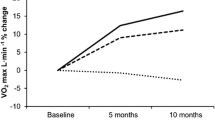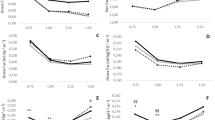Abstract
Purpose
The aims of this study were to: (1) determine the relationships between maximum oxygen uptake (\(\dot {V}\)O2max) and walking economy during non-graded and graded walking among overweight women and (2) examine potential differences in \(\dot {V}\)O2max and walking economy before and after weight loss.
Methods
One-hundred and twenty-four premenopausal women with a body mass index (BMI) between 27 and 30 kg/m2 were randomly assigned to one of three groups: (a) diet only; (b) diet and aerobic exercise training; and (c) diet and resistance exercise training. All were furnished with standard, very-low calorie diet to reduce BMI to < 25 kg/m2. \(\dot {V}\)O2max was measured using a modified-Bruce protocol while walking economy (1-net \(\dot {V}\)O2) was obtained during fixed-speed (4.8 k·h−1), steady-state treadmill walking at 0% grade and 2.5% grade. Assessments were conducted before and after achieving target BMI.
Results
Prior to weight loss, \(\dot {V}\)O2max was inversely related (P < 0.05) with non-graded and graded walking economy (r = − 0.28 to − 0.35). Similar results were also observed following weight loss (r = − 0.22 to − 0.28). Additionally, we also detected a significant inverse relationship (P < 0.05) between the changes (∆, after weight loss) in ∆\(\dot {V}\)O2max, adjusted for fat-free mass, with non-graded and graded ∆walking economy (r = − 0.37 to − 0.41).
Conclusions
Our results demonstrate \(\dot {V}\)O2max and walking economy are inversely related (cross-sectional) before and after weight loss. Importantly though, ∆\(\dot {V}\)O2max and ∆walking economy were also found to be inversely related, suggesting a strong synchrony between maximal aerobic capacity and metabolic cost of exercise.

Similar content being viewed by others
Abbreviations
- ∆\(\dot {V}\)O2max :
-
Delta of maximum oxygen uptake
- ∆walking economy:
-
Delta of waking economy
- Net\(\dot {V}\)O2flat walking :
-
Net oxygen uptake during flat walking
- Net\(\dot {V}\)O2grade walking :
-
Net oxygen uptake during grade walking
- \(\dot {V}\)CO2 :
-
Carbon dioxide production
- \(\dot {V}\)O2 :
-
Oxygen uptake
- \(\dot {V}\)O2flat walking :
-
Oxygen uptake during flat walking
- \(\dot {V}\)O2grade walking :
-
Oxygen uptake during grade walking
- \(\dot {V}\)O2max :
-
Maximum oxygen uptake
- \(\dot {V}\)O2resting :
-
Resting oxygen uptake
References
Coyle EF, Sidossis LS, Horowitz JF, Beltz JD (1992) Cycling efficiency is related to the percentage of type I muscle fibers. Med Sci Sports Exerc 24:782–788
Fisher G, McCarthy JP, Zuckerman PA et al (2013) Frequency of combined resistance and aerobic training in older women. J Strength Cond Res 27:1868–1876. https://doi.org/10.1519/JSC.0b013e31827367e0
Hellerstein HK, Franklin BA (1984) Exercise testing and prescription. In: Wenger NK, Hellerstein NK (eds) Rehabilitation of the coronary patient. Wiley, New York, pp 197–284
Hunter GR, Newcomer BR, Larson-Meyer DE et al (2001) Muscle metabolic economy is inversely related to exercise intensity and type II myofiber distribution. Muscle Nerve 24:654–661
Hunter GR, Bamman MM, Larson-Meyer DE et al (2005) Inverse relationship between exercise economy and oxidative capacity in muscle. Eur J Appl Physiol 94:558–568. https://doi.org/10.1007/s00421-005-1370-z
Hunter GR, McCarthy JP, Bryan DR et al (2008) Increased strength and decreased flexibility are related to reduced oxygen cost of walking. Eur J Appl Physiol 104:895–901. https://doi.org/10.1007/s00421-008-0846-z
Hunter GR, Fisher G, Neumeier WH et al (2015) Exercise Training and Energy Expenditure following Weight Loss. Med Sci Sports Exerc 47:1950–1957. https://doi.org/10.1249/MSS.0000000000000622
Larson-Meyer DE, Newcomer BR, Hunter GR et al (2001) Relation between in vivo and in vitro measurements of skeletal muscle oxidative metabolism. Muscle Nerve 24:1665–1676
Lucía A, Hoyos J, Pérez M et al (2002) Inverse relationship between V O2max and economy/efficiency in world-class cyclists. Med Sci Sports Exerc 34:2079–2084. https://doi.org/10.1249/01.MSS.0000039306.92778.DF
Malatesta D, Simar D, Dauvilliers Y et al (2003) Energy cost of walking and gait instability in healthy 65- and 80-yr-olds. J Appl Physiol 95:2248–2256. https://doi.org/10.1152/japplphysiol.01106.2002
McArdle WD, Katch FI, Katch VL (2010) Exercise physiology: nutrition, energy, and human performance, 7th edn. Lippincott Williams & Wilkins, Philadelphia
McCully KK, Fielding RA, Evans WJ et al (1993) Relationships between in vivo and in vitro measurements of metabolism in young and old human calf muscles. J Appl Physiol 75:813–819. https://doi.org/10.1152/jappl.1993.75.2.813
Montero D, Lundby C (2015) The effect of exercise training on the energetic cost of cycling. Sports Med 45:1603–1618. https://doi.org/10.1007/s40279-015-0380-1
Morgan DW, Daniels JT (1994) Relationship between V O2max and the aerobic demand of running in elite distance runners. Int J Sports Med 15:426–429. https://doi.org/10.1055/s-2007-1021082
Pate RR, Macera CA, Bailey SP et al (1992) Physiological, anthropometric, and training correlates of running economy. Med Sci Sports Exerc 24:1128–1133
Sawyer BJ, Blessinger JR, Irving BA et al (2010) Walking and running economy: inverse association with peak oxygen uptake. Med Sci Sports Exerc 42:2122–2127. https://doi.org/10.1249/MSS.0b013e3181de2da7
Shaw AJ, Ingham SA, Atkinson G, Folland JP (2015) The correlation between running economy and maximal oxygen uptake: cross-sectional and longitudinal relationships in highly trained distance runners. PloS One 10:e0123101. https://doi.org/10.1371/journal.pone.0123101
Acknowledgements
This work was supported by the NIH Grants P30 DK56336, P60 DK079626, UL 1RR025777. Clinical trial “Exercise training in obesity-prone Black and White women”, registration identification number NCT00067873, and url: https://clinicaltrials.gov/ct2/show/NCT00067873?term=gary+hunter&rank=1.
Author information
Authors and Affiliations
Contributions
JB wrote the manuscript and performed data and statistical analysis. SC reviewed and edited the manuscript. HS reviewed and edited the manuscript. GH conceived and designed research, wrote, and reviewed and edited the manuscript. All authors read and approved the manuscript.
Corresponding author
Ethics declarations
Conflict of interest
The authors declared no conflict.
Additional information
Communicated by Jean-René Lacour.
Rights and permissions
About this article
Cite this article
Borges, J.H., Carter, S.J., Singh, H. et al. Inverse relationship between changes of maximal aerobic capacity and changes in walking economy after weight loss. Eur J Appl Physiol 118, 1573–1578 (2018). https://doi.org/10.1007/s00421-018-3888-x
Received:
Accepted:
Published:
Issue Date:
DOI: https://doi.org/10.1007/s00421-018-3888-x




